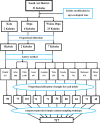Factors associated with wasting and stunting among children aged 06-59 months in South Ari District, Southern Ethiopia: a community-based cross-sectional study
- PMID: 36829183
- PMCID: PMC9950702
- DOI: 10.1186/s40795-023-00683-3
Factors associated with wasting and stunting among children aged 06-59 months in South Ari District, Southern Ethiopia: a community-based cross-sectional study
Abstract
Background: Child undernutrition is a major public health problem in Ethiopia despite different nutrition-specific and sensitive interventions implemented by the government. However, evidence regarding the burden and responsible factors is limited in the South Ari district. Hence, this study aimed to assess factors associated with wasting and stunting among children aged 06-59 months in the South Ari district, Southern Ethiopia, 2021.
Methods: A community-based cross-sectional study was conducted from March 11 to April 11, 2021, among 717 households with at least one child aged 06-59 months. Anthropometric measurements were taken using standard procedures and were converted to height for age Z score and weight-for-height using WHO Anthro software Version 3.2.2. Data were checked and entered into Epi-Data Version 3.1 and analyzed using SPSS Version 25.0. Binary logistic regression analysis was fitted to identify predictors of wasting and stunting. A p-value < 0.05 was used to declare statistical significance.
Result: The prevalence of wasting and stunting among children aged 06-59 months in the district was 9.1% (95% CI: 7.07%, 11.41%) and 59.97% (95% CI: 56.28%, 63.58%), respectively. Family size (8 and above) (AOR = 3.03, 95% CI: 1.31, 7.03), family size (5 to 7) (AOR = 2.05, 95% CI: 1.11, 3.81), poor and medium wealth index (AOR = 3.69, 95% CI: 1.65, 8.26) and (AOR = 2.29, 95% CI: 1.01, 5.16), insufficient maternal knowledge on child feeding practice (AOR = 2.58, 95% CI: 1.31, 5.07), presence of diarrhea in the past two weeks (AOR = 2.05, 95% CI: 1.10, 3.85), non-exclusive breastfeeding (AOR = 2.65, 95% CI: 1.51, 4.65), and birth interval of < 24 months (AOR = 4.49, 95% CI: 2.40, 8.37) were factors significantly associated with wasting. Whereas, children in the age group of 24-59 months (AOR = 2.24, 95% CI: 1.58, 3.16), non-exclusive breastfeeding (AOR = 1.81, 95% CI: 1.24, 2.65), birth interval of fewer than 24 months (AOR = 1.54, 95% CI: 1.11, 2.14), sub-optimal child dietary diversity score (AOR = 1.59, 95% CI: 1.14, 2.22), being a non-beneficiary of productive safety-net program (AOR = 1.91, 95% CI: 1.24, 2.95), and household food insecurity (AOR = 2.60, 95% CI: 1.86, 3.64) were factors significantly associated with stunting.
Conclusions: Wasting and stunting were found to be key public health problems in the South Ari District. Hence, further interventions should consider strategies to enhance household food security and integration of productive safety net programs with primary health care services. Rigorous work is required in advocating and strengthening the provision of family planning services, child care, and integrated management of common childhood illnesses. Moreover, behavioral change communication is highly demanded to improve child feeding practices.
Keywords: Children aged 06–59 months; Ethiopia; Factors; Stunting; Wasting.
© 2023. The Author(s).
Conflict of interest statement
The authors declare that they have no competing interests to disclose.
Figures
References
-
- WHO. Nutrition. 2020; Available from: https://www.who.int/healthtopics/nutrition, Accessed on 28 Oct 2020.
-
- Singh A. Childhood Malnutrition in India. Intech Open. 2020;13.
-
- UNICEF. Nutrition Glossary. 2012; Available from: http://wiredhealthresources.net/presentations/82/story_content/external_..., Accessed on 02 Jan 2020.
-
- Senthilkumar SK, Chacko TV, Suvetha K. Nutritional status assessment of children aged 0–5 years and its determinants in a tribal community of Coimbatore district. Int J Community Med Public Health. 2018;5(7):2835–2845. doi: 10.18203/2394-6040.ijcmph20182610. - DOI
-
- United Nations Children’s Fund (UNICEF). Improving Child Nutrition, The achievable imperative for global progress. 2013; Available from: http://www.unicef.org/publications/index_68661.html Accessed on 02 Jan 2020.
LinkOut - more resources
Full Text Sources
Miscellaneous

